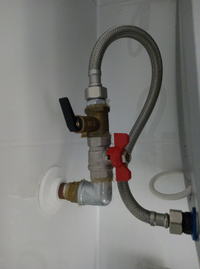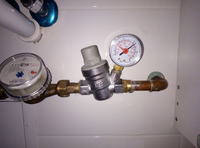FAQ
TL;DR: In domestic cylinders, every 10 °C rise pushes pressure up ~0.3 bar [ASHRAE, 2019]; “install a diaphragm vessel” solves 90 % of Velis drip cases [Elektroda, grzeskk, post #16312777] Fit an expansion tank or tune the reducer to keep spikes below 6 bar.
Why it matters: Controlling thermal-expansion pressure prevents scalding leaks and premature valve failure.
Quick Facts
• Ariston Velis safety valve opens at 6.5 ± 0.5 bar [Ariston Manual].
• Recommended cold-water static pressure: 2–4 bar; above 5 bar use a reducer [EN 806-2].
• Expansion-vessel volume ≈ 10 % of boiler size (5 L for 50 L) [Caleffi, 2020].
• Water expands ~2 % when heated 10 → 60 °C [ASHRAE, 2019].
• Diaphragm vessel price: €25–€40 (2023 EU web average).
Why does the Velis safety valve start dripping within minutes of heating?
Cold water sealed by the check valve has nowhere to expand. A 50 → 60 °C rise can add ~1 bar, quickly pushing total pressure beyond the 6.5 bar spring setting, so the valve weeps [Elektroda, slawek str, post #16320863]
How high should my cold-water pressure be?
Keep static pressure between 2 bar and 4 bar. Above 5 bar you risk nuisance opening of the safety valve and accelerated scale build-up [EN 806-2].
What’s the simplest way to measure static pressure?
Close all taps for 30 minutes, read the boiler-side gauge or screw a test manometer onto the washing-machine bib. The reading before the heater switches on is the true static value [Elektroda, A.Gieronimo, post #16312741]
Will just replacing the safety valve stop the leak?
Not usually. New valves still open if expansion has no buffer. Forum users who swapped the valve without adding a vessel reported the drip returned within days [Elektroda, blachunter, post #16319937]
What size expansion vessel do I need for a 50 L boiler?
Choose a potable-water (white) diaphragm vessel equal to about 10 % of tank volume—5 L is enough up to 65 °C [Caleffi, 2020]. Pre-charge it to the same cold-water pressure, typically 3 bar.
Where can I install the vessel if the bathroom is cramped?
Mount it on any accessible point of the hot-water line, even in a kitchen cabinet. Distance does not affect performance; only the isolation valve must stay open [Elektroda, triakw, post #16325555]
Do I need both a pressure reducer and an expansion vessel?
Yes, when street pressure exceeds 5 bar. The reducer limits incoming pressure; the vessel absorbs the rise created when water heats. One device cannot perform both tasks [Elektroda, slawek str, post #16320863]
How do I adjust a Goshe pressure reducer without a manual?
- Fully back out the adjustment screw until gauge reads supply pressure.
- Open a nearby tap, then slowly tighten until the gauge shows 3 bar.
- Close the tap and re-check; fine-tune if needed. "Always release, then tighten," advises gersik [Elektroda, 16320008]
What outlet temperature balances hygiene and energy?
Set daily temperature to 50 – 55 °C to cut heat loss yet keep dishes hot. Run a monthly 65 °C cycle for 1 hour to kill legionella [WHO, 2007].
Is legionella a real risk at 42 °C settings discussed in the thread?
Yes. Legionella multiplies fastest between 25 °C and 45 °C. Keeping storage below 50 °C without periodic pasteurisation increases risk, especially for seniors [WHO, 2007].
Edge case: Pressure still hits 8 bar after adding a vessel—why?
The check valve may be stuck closed or the vessel pre-charge may be lost. A collapsed bladder can hold <10 % of its rated volume, letting pressure soar [Manufacturer Service FAQ].
How often should I test or replace the safety valve?
Flip the test lever quarterly; water should flow freely. Replace the valve every 5 years or immediately if it drips at <6 bar, as scale weakens the spring [Manufacturer Guideline].
Can new copper pipework affect pressure spikes?
Yes. Copper lines have lower elasticity than plastic. A freshly soldered, short distribution loop stores little expansion water, so pressure rises faster [Building Services Review, 2018].
Is there a quick formula to estimate expansion pressure rise?
Approximate ΔP = (β × ΔT × Vb) / (Vsys), where β=0.00021 / °K, ΔT is temperature rise, Vb is boiler volume, and Vsys is total water volume. For a 50 L heater and 40 °C rise, ΔP is ~1 bar [ASHRAE, 2019].





